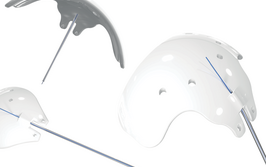
From Eye to Infant
Drugs used to treat retinal disorders appear to pass into breast milk, posing a potential risk to the normal development of nursing infants
Mothers are typically advised to breastfeed their newborns, but for those who live with medical conditions, managing the symptoms of their illnesses while nursing can present challenges. Research led by St. Michael’s Hospital in Toronto, Canada, indicates that the anti-VEGF drugs ranibizumab and aflibercept are able to enter the breast milk of breastfeeding mothers, potentially raising concerns about possible adverse events in the developing infant (1). Notably, according to the labels on both drugs, it is unknown if the molecules are excreted in human breast milk.
The team found that the anti-VEGFs studied were able to reach a mother’s systemic circulation in the first few days following intravitreal injection – and, from there, enter the breast milk of lactating patients. Rajeev Muni, a vitreoretinal surgeon, and Verena Juncal, a retinal fellow, who co-led the first-of-its-kind study – do not know exactly how anti-VEGF drugs enter into breast milk, but it appears to be dependent on several variables, including drug lipophilicity, molecular size and drug levels in maternal blood.
“Though the mechanism that allows anti-VEGF agents to enter the bloodstream hasn’t been fully elucidated, it is known that large amounts of VEGF are present in breastmilk and that it binds to specific receptors in the intestinal epithelium of newborns,” says Muni. “The binding of VEGF at these sites is thought to play an immunomodulatory role in the newborn’s intestine, and in the systemic circulation, VEGF plays a role in angiogenesis and vascular permeability.”
Juncal explains the importance of the finding: “The main concern is not only that the baby is constantly receiving breast milk with reduced VEGF levels for a long period of time, but also that the baby could be absorbing the drug into the systemic circulation and, thereby, causing suppression of VEGF systemically.”
In three women included in the study, one continued to breastfeed while receiving intravitreal ranibizumab therapy, one discontinued nursing immediately before receiving a ranibizumab injection, and the third chose not to breastfeed at all and was started on intravitreal aflibercept. Both ranibizumab and aflibercept were detected in the breast milk of the patients who were not actively breastfeeding. In the mother who continuously breastfed, drug levels were not detected – likely because the drug in the breast milk was constantly excreted and ingested by the infant and never accumulated sufficiently.
The lack of controlled data about anti-VEGF drugs in human pregnancy means that they are considered category C drugs, implying that potential effects to the fetus cannot be ruled out. However, while other treatment options exist, anti-VEGF drugs cannot always be avoided for the treatment of certain conditions. Indeed, some mothers may choose to breastfeed while requiring months, or in some cases, years of treatment.
The researchers admit the sample size is small, due to the fact that this situation does not frequently present itself. However, they explained that if the drug reaches the breast milk in a small number of patients, the same would happen in a larger number as the biological process is the same. “It would have been very difficult to find a large cohort of patients, but every retina specialist will likely face this situation at some point in their career. With these three patients, we have definitively shown that the drugs reach the breast milk with a corresponding decline in breast milk VEGF levels,” says Muni.
Juncal went on to express the importance of updating product labelling to ensure patients and physicians were aware of the potential effects of these drugs.

- R Muni et al. “Ranibizumab and Aflibercept Levels in Breast Milk after Intravitreal Injection”. Available at: https://bit.ly/2oycFQP. Accessed September 30, 2019.













